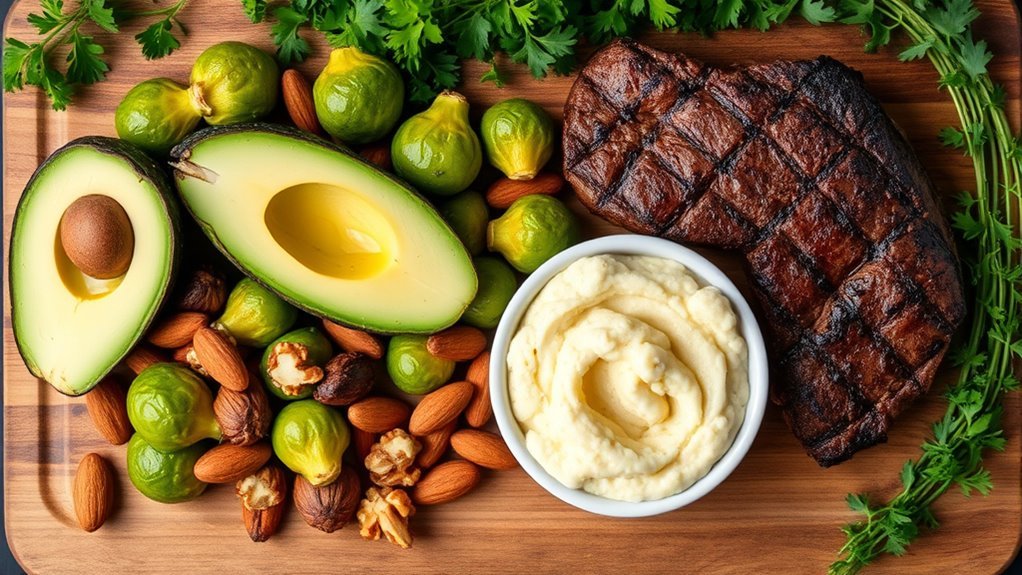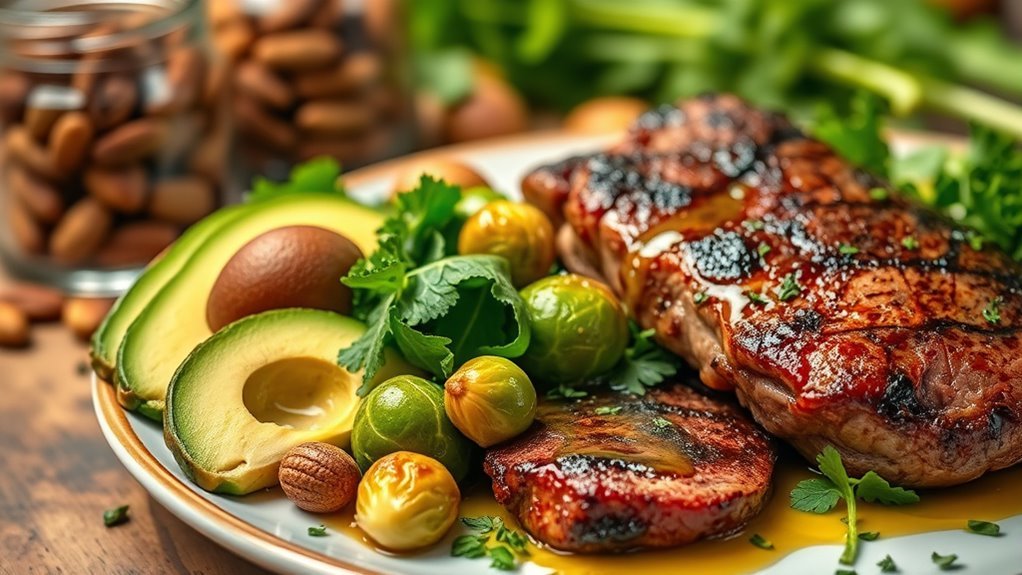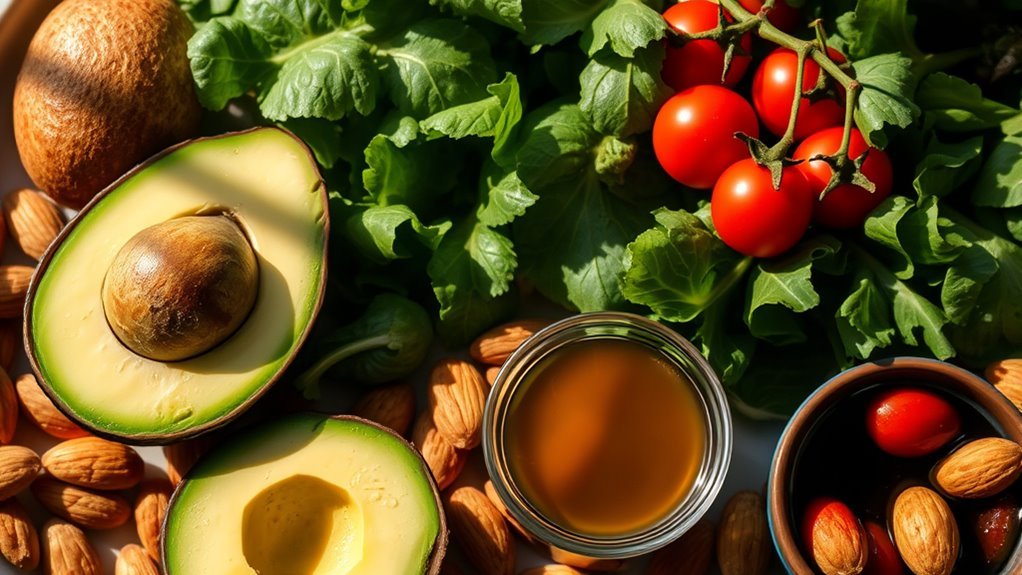Keto is a low-carbohydrate, high-fat diet that shifts your body into ketosis, a state where it burns fat for energy instead of glucose. This metabolic change can enhance mental clarity and improve energy levels. A typical keto diet consists of about 70-75% fats, 20-25% protein, and just 5-10% carbohydrates. While it offers numerous benefits, some common mistakes can sabotage your efforts. There’s much more to explore about making keto work for you.
Understanding Ketosis

Ketosis is a metabolic state where your body shifts from using glucose as its primary fuel source to burning fat for energy. This transformation occurs through ketosis mechanisms, where your liver converts fatty acids into ketones, providing an alternative energy source. As you adapt, your body undergoes metabolic adaptation, enhancing its efficiency in utilizing fat. This shift can lead to increased energy levels and improved mental clarity for many. Understanding these processes helps you appreciate the freedom and flexibility that come with a ketogenic lifestyle, empowering you to make informed choices about your nutrition and health. Embracing ketosis can redefine your relationship with food.
Macronutrient Breakdown

As your body adapts to ketosis, understanding the macronutrient breakdown becomes vital for maintaining this metabolic state. Typically, a keto diet consists of about 70-75% fats, 20-25% protein, and 5-10% carbohydrates. These macronutrient ratios help your body efficiently burn fat for fuel. When selecting protein sources, consider options like fish, lean meats, and eggs, which provide essential amino acids without excessive carbs. Balancing your intake is significant; too much protein can kick you out of ketosis, while inadequate fats may hinder your energy levels. Embracing this breakdown empowers you to thrive in your keto journey, promoting freedom in your dietary choices.
Benefits of the Keto Diet

While many people turn to the keto diet for weight loss, its benefits extend beyond just shedding pounds. Adopting a low-carb, high-fat lifestyle can enhance mental clarity, as your brain utilizes ketones more efficiently than glucose. This shift often leads to improved focus and productivity. Additionally, the keto diet may stabilize blood sugar levels, reducing cravings and maintaining energy throughout the day. Some studies suggest it can even support heart health by improving cholesterol markers. Ultimately, embracing keto can offer you a sense of freedom, not just in your weight but in your overall well-being and cognitive function.
How to Get Started
If you’re ready to experience the benefits of the keto diet, getting started involves a few key steps. First, focus on meal planning to guarantee your meals are low in carbs and high in healthy fats. Create a weekly menu that includes keto-friendly foods like avocados, nuts, and lean proteins. Next, hit the grocery store with a detailed list to avoid impulse buys. Stick to the perimeter of the store, where fresh produce and meats are usually found. Remember, preparation is essential for success. With these strategies, you’ll set yourself up for a smooth change into the keto lifestyle.
Common Mistakes to Avoid
Even though the keto diet can offer numerous health benefits, many newcomers fall into common pitfalls that can hinder their progress. One mistake is neglecting meal planning; without it, you might find yourself reaching for high-carb foods. Additionally, improper carb counting can sabotage your efforts. It’s essential to accurately track your carb intake to stay within your daily limits. Another common error is not staying hydrated, which can lead to fatigue and cravings. Remember, embracing the keto lifestyle isn’t just about restricting carbs—it’s also about enjoying your meals and maintaining balance for long-term success. Stay mindful, and you’ll thrive!
Foods to Include
To successfully navigate the keto diet, understanding which foods to include is key. Focus on healthy fats like avocados, nuts, and olive oil, as they’ll keep you satisfied and energized. Incorporate low-carb vegetables such as spinach and broccoli for essential nutrients. Don’t forget about protein sources like grass-fed meats, eggs, and seafood. For those moments when you crave a treat, opt for keto snacks like cheese crisps or nut butter. By prioritizing these foods, you can enjoy a variety of delicious meals while maintaining ketosis, giving you the freedom to thrive on your keto journey.
Foods to Limit or Avoid
While embracing the keto diet, it’s essential to limit or avoid certain foods that can hinder your progress. These include processed sugars, refined grains, and starchy foods that can spike your carb intake. You’ll also want to steer clear of high carb vegetables, sugary snacks, certain fruits, legumes, and unhealthy fats. Here’s a quick reference table to guide you:
| Foods to Limit/Avoid | Reason |
|---|---|
| Processed Sugars | High in carbs |
| High Carb Vegetables | Can disrupt ketosis |
| Refined Grains | Increase insulin levels |
| Sugary Snacks | Packed with empty calories |
| Certain Fruits | High in natural sugars |
The Role of Supplements
As you explore the keto diet, you might find that supplements can play a significant role in supporting your nutritional needs. Keto supplements, such as exogenous ketones, electrolytes, and MCT oil, can enhance your energy levels and help maintain ketosis. Nutrient timing is also vital; consider taking supplements around your workouts to optimize performance and recovery. While whole foods should be your priority, supplements can bridge nutritional gaps, especially during the initial adaptation phase. Remember, it’s important to choose quality products and consult with a healthcare provider to guarantee you’re meeting your specific requirements on your keto journey.
Potential Risks and Considerations
Although the keto diet can offer numerous benefits, it’s important to be aware of potential risks and considerations that may arise during your journey. Individual variability means that not everyone will respond the same way, which can lead to health concerns for some. Here’s a quick overview:
| Risk/Concern | Description | Mitigation Strategies |
|---|---|---|
| Nutrient Deficiency | Limited food variety can cause deficiencies | Incorporate supplements |
| Digestive Issues | Some experience constipation or diarrhea | Increase fiber intake gradually |
| Keto Flu | Initial flu-like symptoms may occur | Stay hydrated and rest |
| Blood Sugar Levels | May fluctuate, especially in diabetics | Regular monitoring is essential |
| Heart Health | High saturated fat intake concerns | Choose healthy fats |
Long-Term Sustainability and Lifestyle Changes
Steering through the keto diet isn’t just about short-term gains; it’s also about how you can maintain these changes over the long haul. Long-term adherence requires thoughtful lifestyle adjustments that fit your unique needs. Here are some tips to contemplate:
Navigating the keto diet involves sustainable lifestyle changes for lasting success and personal well-being.
- Focus on whole foods for better nutrient intake.
- Allow occasional treats to avoid feelings of deprivation.
- Stay hydrated and monitor your electrolytes.
- Engage in social activities that support your diet.
- Keep a food journal to track progress and feelings.


